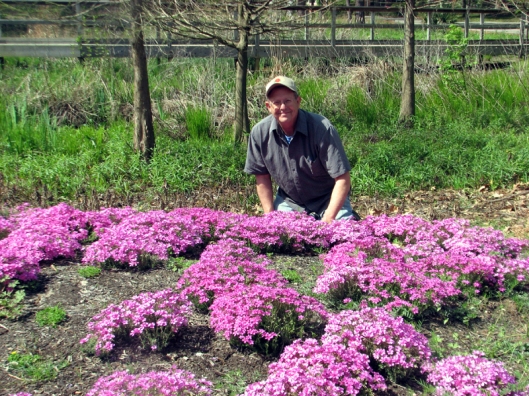Phlox nivalis ssp. texensis, Texas trailing phlox, is a beautiful little plant and one of the rarest globally endangered phloxes. It’s been listed as endangered globally since 1991. The Texas Parks and Wildlife has a heavy interest in the species and is managing a recovery program.
http://tpwd.texas.gov/huntwild/wild/species/trlphlox/
Listed as occurring in 21 sites n Hardin, Polk, and Tyler counties in East Texas, the species is endangered because of habitat loss due to canopy closure, fire suppression, encroachment by woody vegetation, deer and other herbivores, and land disturbance by man.

2010 image of Texas Trailing Phlox plot at SFA Gardens, Nacogdoches, TX

Texas trailing phlox in 2010 – this plot no longer exists – but our work will return soon in another spot
The home of Texas trailing phlox is best characterized as open pine woodlands with generally sandy soils and a dry upland vegetational pattern. This attractive evergreen makes a matting clump to a foot or two wide and six to nine inches high. Texas trailing phlox plants are herbaceous or subshrubby and reported to grow any time temperatures and moisture levels are right. Showy lavender flowers and a strong temperament when properly sited makes this species one of the diminutive treasures in the pineywoods of East Texas. Work to rescue the species increased in the 1980’s and 1990’s after Mahler in 1980 reported only a few Texas trailing phlox populations left in the wild and a species threatened with extinction. The species is federally listed as endangered (56 FR 49636; September 30, 1991) and without critical habitat. For those interested, when you Google for the status report for Texas trailing phlox it’s the recovery plan prepared by Dr. Michael Warnock, Biologist, Sam Houston State University (Warnock 1994) that pops up.
We’ve been working with Texas trailing phlox for a long time. From 20 plants received from Greg Wieland of the Center for Plant Conservation in December, 1995, SFA graduate research assistant Chris Jones produced over 1200 individuals via mist propagation (1-2-inch cuttings; composted pine bark:perlite at a 1:1 ratio; intermittent mist for three weeks; moved to shade house for two time daily watering; and slow-release fertilizer to push the plants in one gallons of 20% coarse sand and 80% composted pine bark). While the literature remains scant, many workers report that seed is not easy and seedlings are prone to damping off. Wieland achieved success with cuttings stuck in a no-mist, high humidity shade environment (personal communication 1995). He is working with a pool of documented plants, the same pool provided to this project. In a telephone query to Bob McCartney at Woodlanders Nursery in Aiken, Georgia, Bob noted that the general procedure with Phlox nivalis (the species type) was quite simple: no-mist, deep, sharply drained media beds, with two or three irrigations per day, under partial shade (personal communication 1996). McCartney is a nationally known plant hunter, nurseryman-botanist, contributor to learned societies, well-versed, and often somewhat outspoken, in the wonderful world of endangered plants of the southeast.

From introductions into the wild, we have learned that it’s best to introduce plants that are grown on the “lean” side. That is, plants that aren’t heavily fertilized and succulent. Why? The answer is deer. Plants grown in small containers are fine and planted properly across a broad crossection of the target are prudent.
Little is known regarding Texas trailing phlox ecology, reproductive biology, cultural needs, or propagation characteristics. Provided the right approach is discovered, the chances are excellent that the species can be rooted in high numbers. However, the scientific community generally agrees that reintroduction and “introduction-into-the-wild” projects should prefer to work with seedlings whenever possible. There is little academic doubt that there’s danger in restricting the gene pool via the use of a high percentage of cutting-grown plants in reintroduction work. Seed-grown progeny insure the most genetic diversity possible thus increasing the chances for the long-term survival of a species.
The SFA Gardens goals in the endangered plants arena are really quite modest. We have a mantra we call the “three R’s” conservation program for protecting many of the endangered plants of East Texas: rescue, research, and reintroduction. This is not a unique program and it’s no accident that many botanical gardens and arboreta (over 500 in the U.S.) have initiated some kind of endangered plant conservation program. While zoo endangered animal programs have caught the public’s attention and the big dollars, we should never forget that plant scientists in universities, botanical gardens, arboreta, or state and federal agencies have been quietly making a difference for many threatened plants.
References:
McCartney, Bob. 1996. Personal communication. Woodlanders Nursery, Aiken, Georgia.
Mahler, W.F. 1980. Status report Phlox nivalis ssp. texensis. USFWS, Albuquerque, NM. 12pp.
Nemec, Kathy. 1996. Personal communication. USFWS, Houston, TX.
Warnock, Michael. 1994. Texas trailing phlox recovery plan. U.S. Fish and Wildlife Service, Albuquerque, New Mexico. 42 pp.
Wieland, Gregg. 1995. Personal communication. CPC, Mercer Arboretum, Houston, TX.
